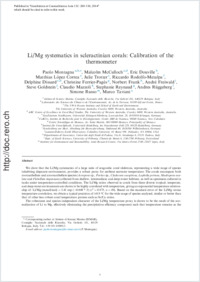Li/Mg systematics in scleractinian corals: Calibration of the thermometer
- Montagna, Paolo Istituto di Scienze Marine, Consiglio Nazionale delle Ricerche, Bologna, Italy - Laboratoire des Sciences du Climat et de l’Environnement, Gif-sur-Yvette, France
- McCulloch, Malcolm The UWA Oceans Institute and School of Earth and Environment, The University of Western Australia - ARC Centre of Excellence in Coral Reef Studies, The University of Western Australia
- Douville, Eric Laboratoire des Sciences du Climat et de l’Environnement, Gif-sur-Yvette, France
- Correa, Matthias López GeoZentrum Nordbayern, Universität Erlangen-Nürnberg, Germany
- Trotter, Julie The UWA Oceans Institute and School of Earth and Environment, The University of Western Australia
- Rodolfo-Metalpa, Riccardo CoRéUs, Institut de Recherche pour le Développement, Centre IRD de Noumea, New Caledonia
- Dissard, Delphine The UWA Oceans Institute and School of Earth and Environment, The University of Western Australia - ARC Centre of Excellence in Coral Reef Studies, The University of Western Australia
- Ferrier-Pagès, Christine Centre Scientifique de Monaco, Principality of Monaco
- Frank, Norbert Institut für Umweltphysik, Universität Heidelberg, Germany
- Freiwald, André Senckenberg am Meer, Abteilung für Meeresforschung, Südstrand 40, D-26384 Wilhelmshaven, Germany
- Goldstein, Steve Lamont-Doherty Earth Observatory, Columbia University, USA
- Mazzoli, Claudio Dipartimento di Geoscienze, Università degli Studi di Padova, Italy
- Reynaud, Stephanie Centre Scientifique de Monaco, Principality of Monaco
- Rüggeberg, Andres Dept. of Earth Sciences, University of Fribourg, Switzerland
- Russo, Simone Institute for Environment and Sustainability, Joint Research Centre, Ispra, Italy
- Taviani, Marco Istituto di Scienze Marine, Consiglio Nazionale delle Ricerche, Bologna, Italy
-
01.05.2014
Published in:
- Geochimica et Cosmochimica Acta. - 2014, vol. 132, p. 288–310
English
We show that the Li/Mg systematics of a large suite of aragonitic coral skeletons, representing a wide range of species inhabiting disparate environments, provides a robust proxy for ambient seawater temperature. The corals encompass both zooxanthellate and azooxanthellate species (Acropora sp., Porites sp., Cladocora caespitosa, Lophelia pertusa, Madrepora oculata and Flabellum impensum) collected from shallow, intermediate, and deep-water habitats, as well as specimens cultured in tanks under temperature-controlled conditions. The Li/Mg ratios observed in corals from these diverse tropical, temperate, and deep-water environments are shown to be highly correlated with temperature, giving an exponential temperature relationship of: Li/Mg (mmol/mol) = 5.41 exp (−0.049 * T) (r² = 0.975, n = 49). Based on the standard error of the Li/Mg versus temperature correlation, we obtain a typical precision of ±0.9 °C for the wide range of species analysed, similar or better than that of other less robust coral temperature proxies such as Sr/Ca ratios.The robustness and species independent character of the Li/Mg temperature proxy is shown to be the result of the normalization of Li to Mg, effectively eliminating the precipitation efficiency component such that temperature remains as the main controller of coral Li/Mg compositions. This is inferred from analysis of corresponding Li/Ca and Mg/Ca ratios with both ratios showing strong microstructure-related co-variations between the fibrous aragonite and centres of calcification, a characteristic that we attribute to varying physiological controls on growth rate. Furthermore, Li/Ca ratios show an offset between more rapidly growing zooxanthellate and azooxanthellate corals, and hence only an approximately inverse relationship to seawater temperature. Mg/Ca ratios show very strong physiological controls on growth rate but no significant dependence with temperature, except possibly for Acropora sp. and Porites sp. A strong positive correlation is nevertheless found between Li/Ca and Mg/Ca ratios at similar temperatures, indicating that both Li and Mg are subject to control by similar growth mechanisms, specifically the mass fraction of aragonite precipitated during calcification, which is shown to be consistent with a Rayleigh-based elemental fractionation model.The highly coherent array defined by Li/Mg versus temperature is thus largely independent of coral calcification mechanisms, with the strong temperature dependence reflecting the greater sensitivity of the KdLi/Ca partition coefficient relative to KdMg/Ca. Accordingly, Li/Mg ratios exhibit a highly coherent exponential correlation with temperature, thereby providing a more robust tool for reconstructing paleo-seawater temperatures.
- Faculty
- Faculté des sciences et de médecine
- Department
- Département de Géosciences
- Language
-
- English
- Classification
- Meteorology, climatology
- License
-
License undefined
- Identifiers
-
- RERO DOC 211435
- DOI 10.1016/j.gca.2014.02.005
- Persistent URL
- https://folia.unifr.ch/unifr/documents/303744
Statistics
Document views: 119
File downloads:
- pdf: 269
